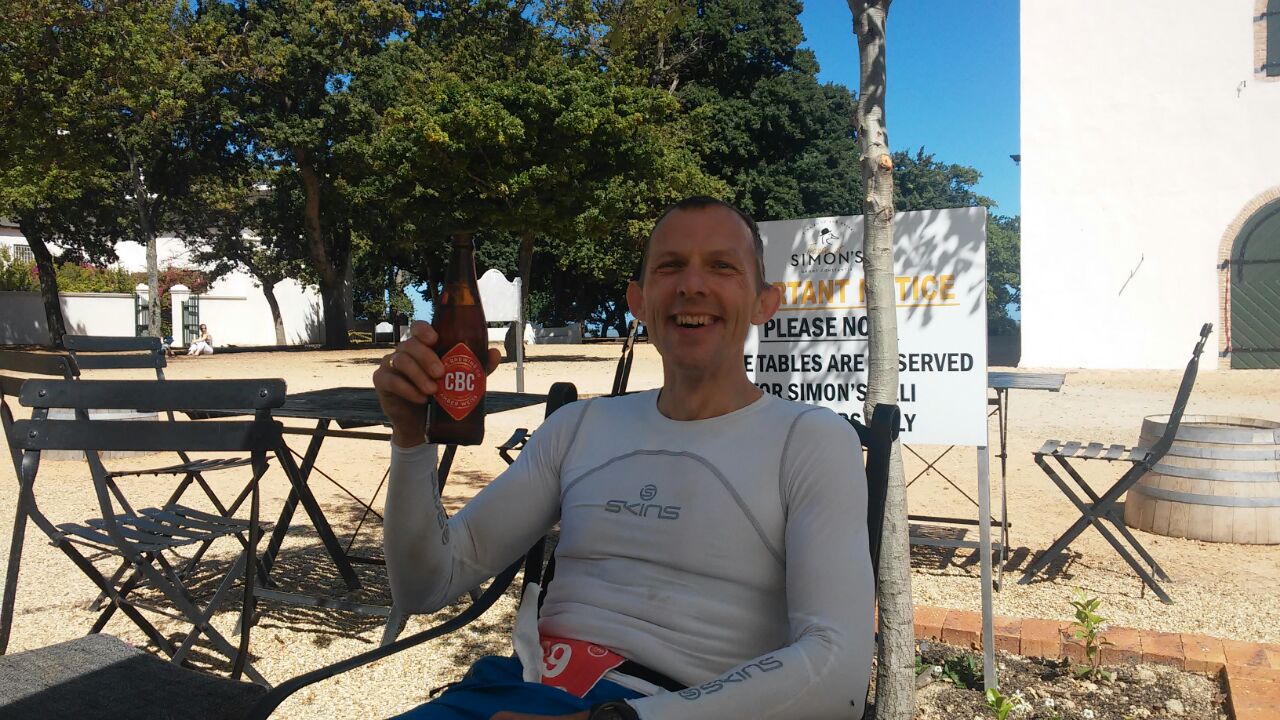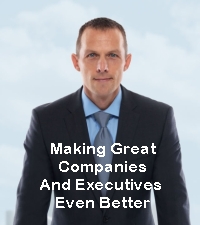From Constantia Nek to Llandudno Beach (Aid Station #4, 37.5 km)
I was looking forward to a rather downhill part of the route towards Llandudno Beach. I ran here during one of the Recce’s, but it had more technical elements than I could recall, which was slowing me down.
But my pace was fine, no worries at all. It’s another beautiful part of the race overlooking Hout Bay. You can see Suther Peak looming ahead of you – the next mountain to climb…
Eventually I made it to Llandadno Aid Station A4 after 5h 35 min (as planned) in quite good mood, as you can see in this picture.
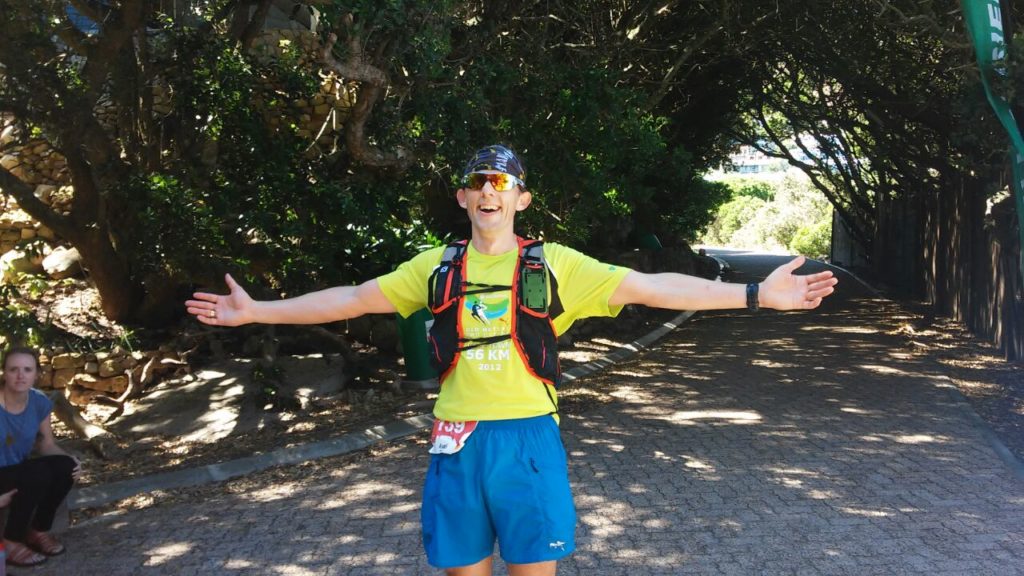
Pretty upbeat at Llandudno
My wife, our dogs and our friend Andrew were waiting for me to support me mentally and with fresh food and drinks. It was also time to prepare for the heat, since most of the clouds were gone in the meantime. I spend about 10 minutes here, enjoying also a shower with cold water. I put on my heat gear, drank a smoothie, a carrot juice and Andrew refilled one of my flasks with coconut water (one of my ultra trail secret weapons :).
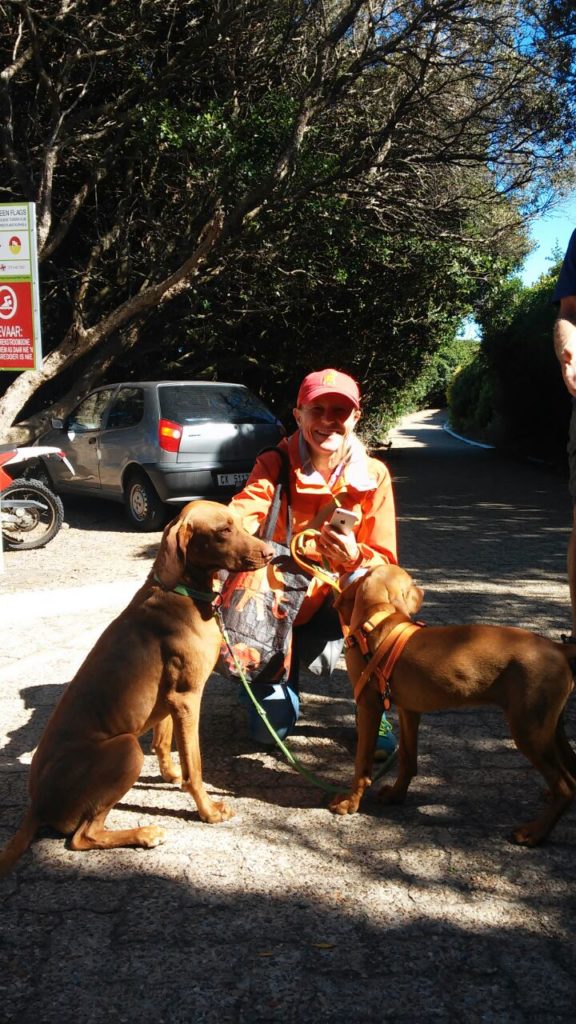
My wife Silke and our dogs Amy and Lara
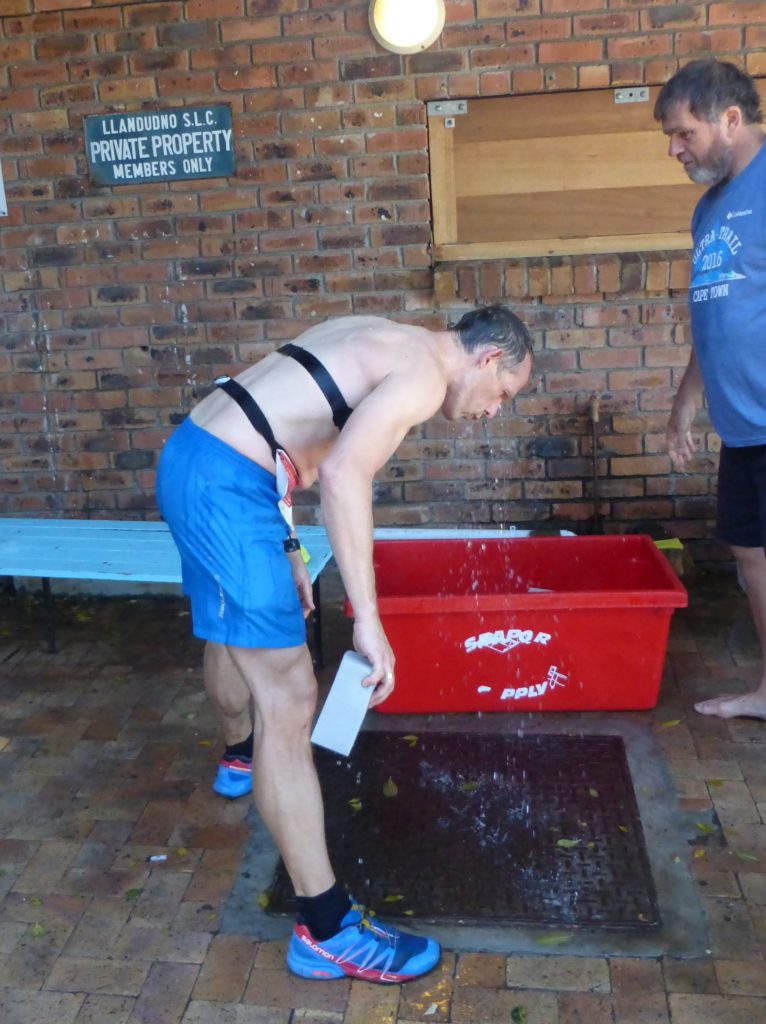
Ice cold shower before taking on my heat gear (long sleeve shirt)
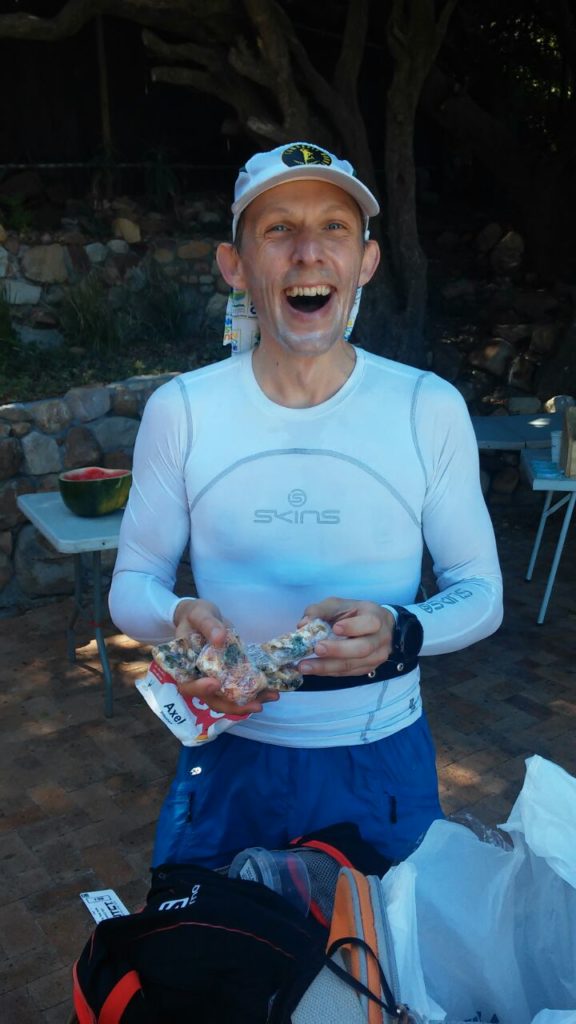
Fresh sunscreen in my face and restocking on food (my famous pizza packs)
Now the real challenge of the first half was waiting for me: Climbing up Suther Peak. From Llandudno beach it’s just 8 km to the top with 600 m elevation climb, but it took me almost 2 hours to get there! Luckily I already knew how tough this is and made my plans according to the challenge.
Again, really beautiful and it’s different, including some serious boulder climbing along the Atlantic ocean, mountain climbing and even (unexpectedly) abseiling…
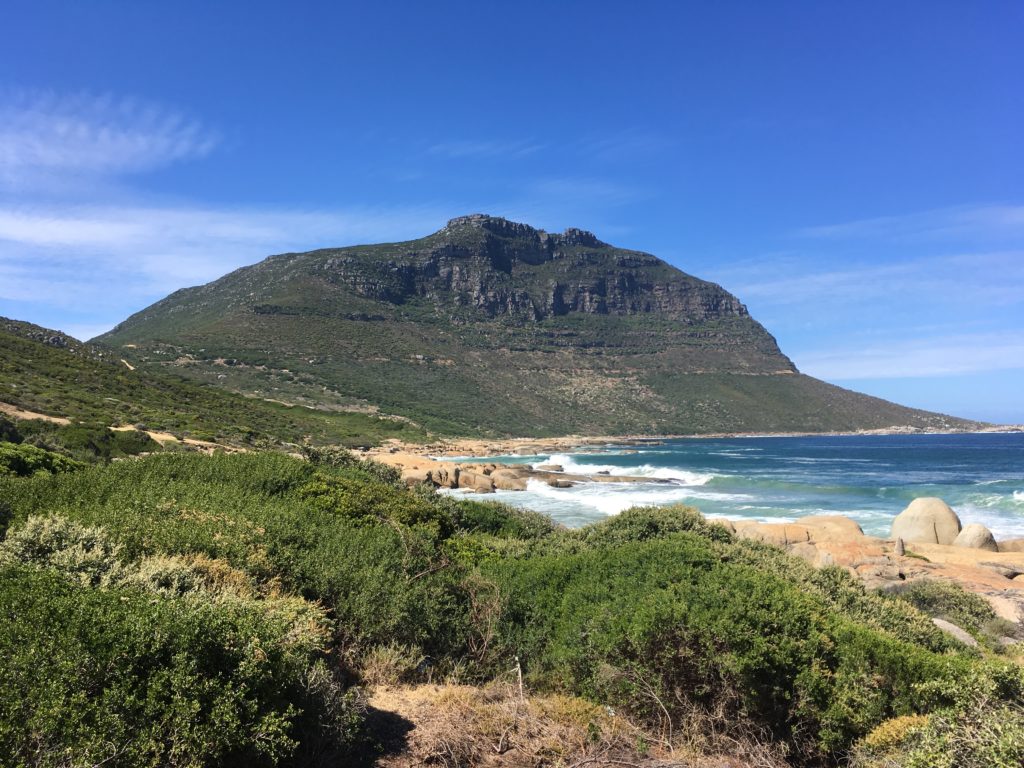
Yes, that’s one of several mountains we had to climb – Suther Peak
I met two other runners which I first saw running ahead of me at the beach and it took a very long time to get closer. I eventually caught them after the first steep uphill section. My ankle still was working fine, but I was very careful especially hopping those boulders.
One of the UTCT photographers took a picture of me while I was taking a picture ?
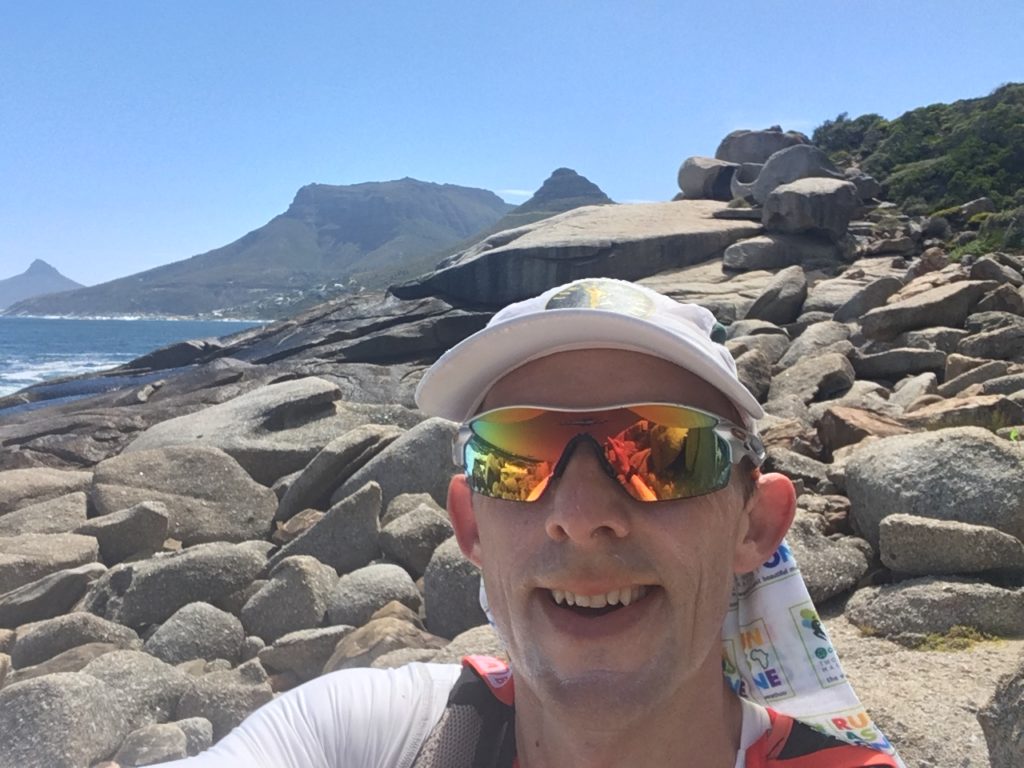
Serious boulders, Lions Head and Little Lions Head in the back – as well as the burning sun
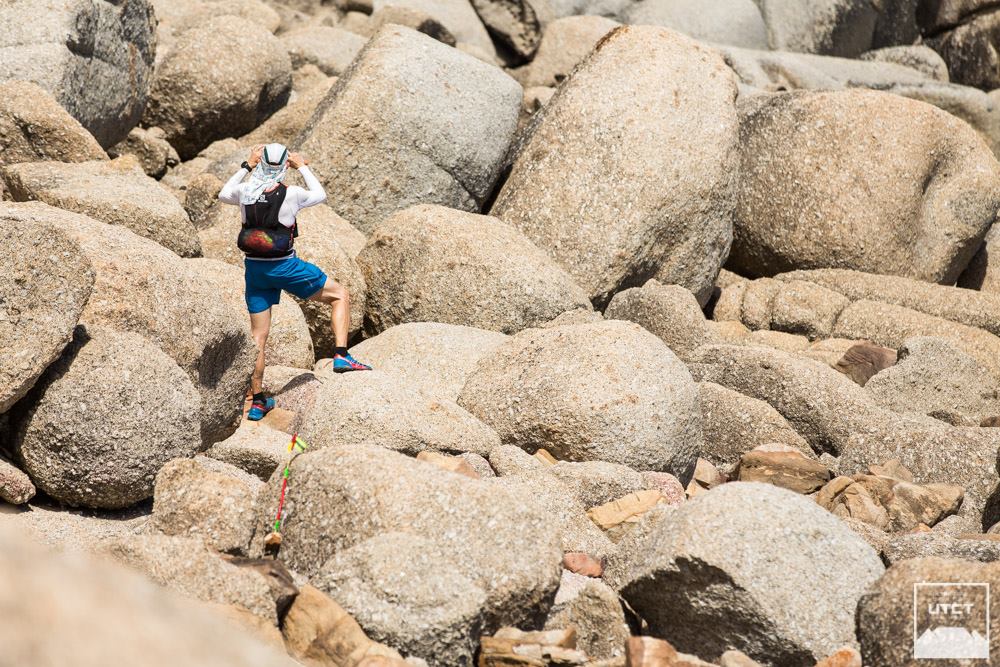
Yep, those boulders are HUGE; picture (C) by UTCT
During a flat section, the only one on our ascent to Suther Peak, I met Henri again. The runner who saved me from going into the wrong direction at Constantia Nek. He was limping and he expressed his doubts if he would make it. He also rolled his ankle… We shared our experiences and wished each other luck. With the next cut off looming he sent me off and I approached the mountain climbing part…40 minutes of fighting with heat and rocks.
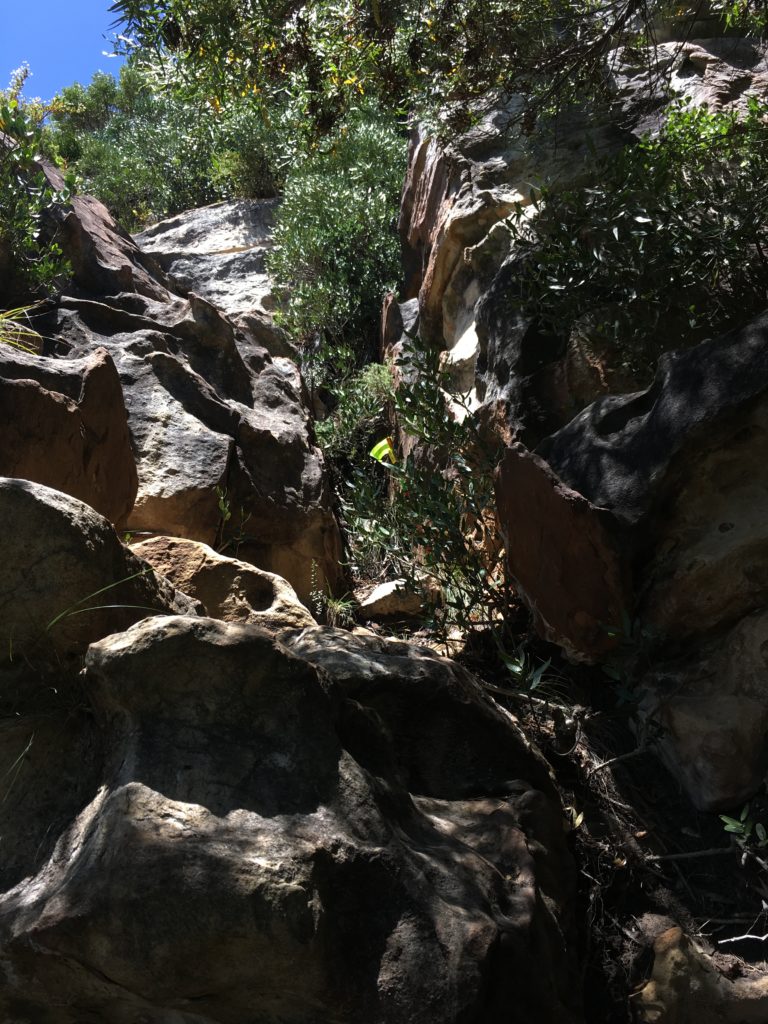
Yes, there is a path… Find the little yellow flag…
On my ascent I met a runner sitting in the shade, nibbling on some food. I asked him how he felt, and he was struggling big time. He said he lacked energy, but eventually he started moving again. Later I heard that he sat there for 45 min already and had passed out as well. Luckily he made it to an Aid Station and withdrew from the race. He overpaced himself, running in the top 20% of the field after 30 km, but had to pay his dues for that pace. Another proof of how hard running and the UTCT 100 km can be.
Later, I was still climbing, I met another runner and he was struggling with cramps. I asked him if he ever tried a salt-tablet and he said no. So I gave him one of mine and used it as a reminder for myself to take one as well. It was my intention to swallow a salt tablet every 2-3 hours, and this was my second one. They did help me to avoid cramping during the race. The tablet seemed to have given him a mental boost and he carried on.
The climb didn’t seem to stop. Whenever I reached a peak, there was another peak behind. I mean, I knew it from looking at the altitude indicator of my watch, but still I was hoping that the peak would be near.
Reaching the top of Suther Peak after 7h 35 min
After 7h 35 min I reached the top and – in my opinion – the most dangerous part of the race: An approx. 3 m high boulder of which we had to „abseil“ ourself. Yes, there was a rope for us to somehow get us down that rock. Boy that was a mission. We managed this and I carried on while he fell back.
I knew the next section towards Hout Bay would be a nice path to run, not too difficult. I enjoyed it a lot and was looking forward to getting to the next Aid Station, also hoping to see my friends again. Hout Bay marks the half way point and the cut of there was 8 hour and 45 minutes.
Where the DNF happened
But I still had to get there. And then it happened. After some 48km or so on a nice and relatively easy to run downhill path I slipped and rolled my ankle for the third time. And this time it was extremely painful. I sank to the ground (don’t know if you can say that, but what I mean is, I did not fall, but when I rolled my ankle I somehow tried to avoid the strain and simply went down to my knees or so) and screamed in pain. There I sat, down in the sand, holding my ankle not knowing, what happened and what’s going to happen.
What felt like sitting there for five minutes turned out, looking at my Garmin records, to be just 2 short minutes, but it shattered me. I tried to stand up, and it worked. I tried to move, and it worked but I was in pain. Slowly I got forward, scared at every step with my right food. And my mind went crazy… What shall I do? Should I continue? Would I make it worse? Is it just a slight injury and I am safe to continue? Would I damage my ankle even more if I’d ran further?
Heading towards Hout Bay Aid Station was more a fast walk than a real run. I took very short steps and did not feel well at all.
Aid Station #5 at Hout Bay harbour, 52 km
I reached Hout Bay Aid Station Number 5 (52 km) after 8 hours and 30 minutes, exactly half of the total 17 h cut off. I sat down for 6 minutes, eating lots of slices of water melon, the only thing I could eat. There is nothing better than water melon on a hot day of exercising. The crew at the aid station was very caring, serving me also several cups of Coke and refilled my water flasks. For the first time I had a proper look at my ankle. It was quite swollen and I put some ice cubes in my socks. What should have made me nervous: I did not feel the ice…
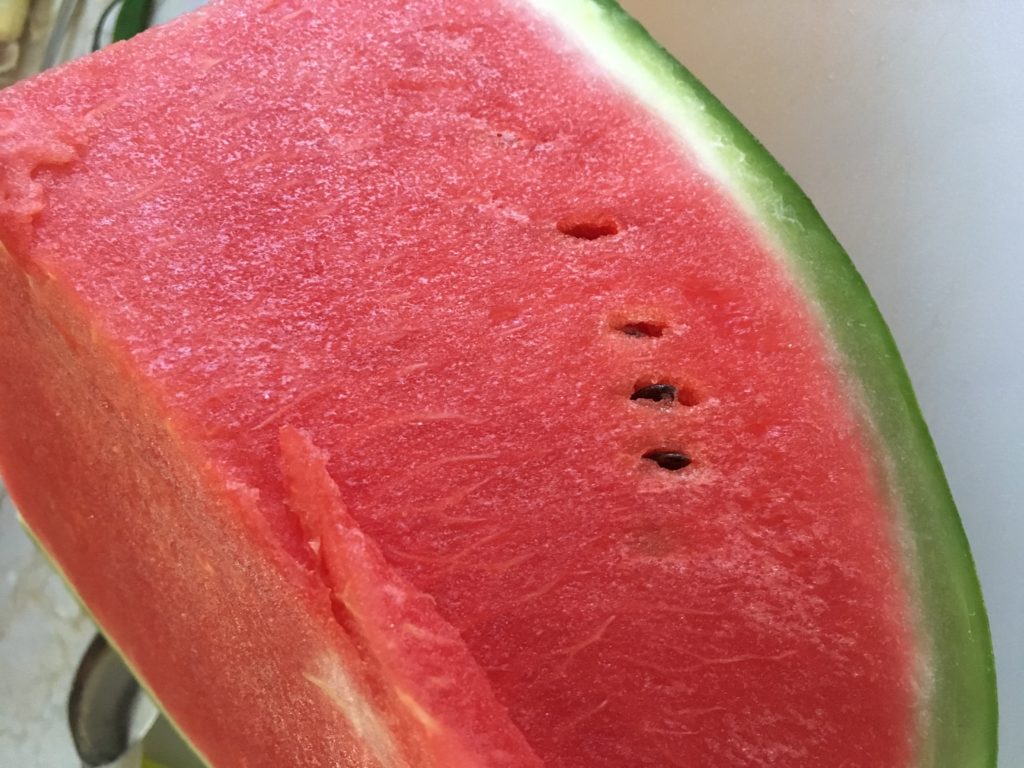
Water melon on a hot day – delicious
The runner sitting next to me also suffered, another one was already lying in one of the busses, ready for runners that did not continue. I knew that my friends Andrew, Julia and Silke were somewhere around the corner, so I left the Aid Station.
Now it got even hotter. There was almost no wind at all and the sun was burning – since it was almost 1 pm. I headed for the beach which we had to cross and run along, but I was not able to run. So I continued to walk, fighting with the pain. Whenever my foot slipped in the sand, which happens often in soft sand, another sting of pain went through my body. „Should I carry on? Should I stop? Is it just temporary?“.
Eventually I got out of the sandy section onto a 100 m road section. And there were Andrew, Julia and Silke.
For reasons he could not explain, Andrew had packed two ice packs into the cooler box before they left home. He brought me one and I fixed it to my leg with the tape I was supposed to carry with me anyhow. „Why didn’t I fix my ankle with the tape earlier?“ went through my mind. Another proof of the fact that runners can’t think straight after a while. Anyway, the ice pack did its wonders and I felt so much better. Before my support crew left me we discussed that I’d try to get to the next Aid Station 6, maybe 6 km away from we were standing. That was my next goal. Just get there.
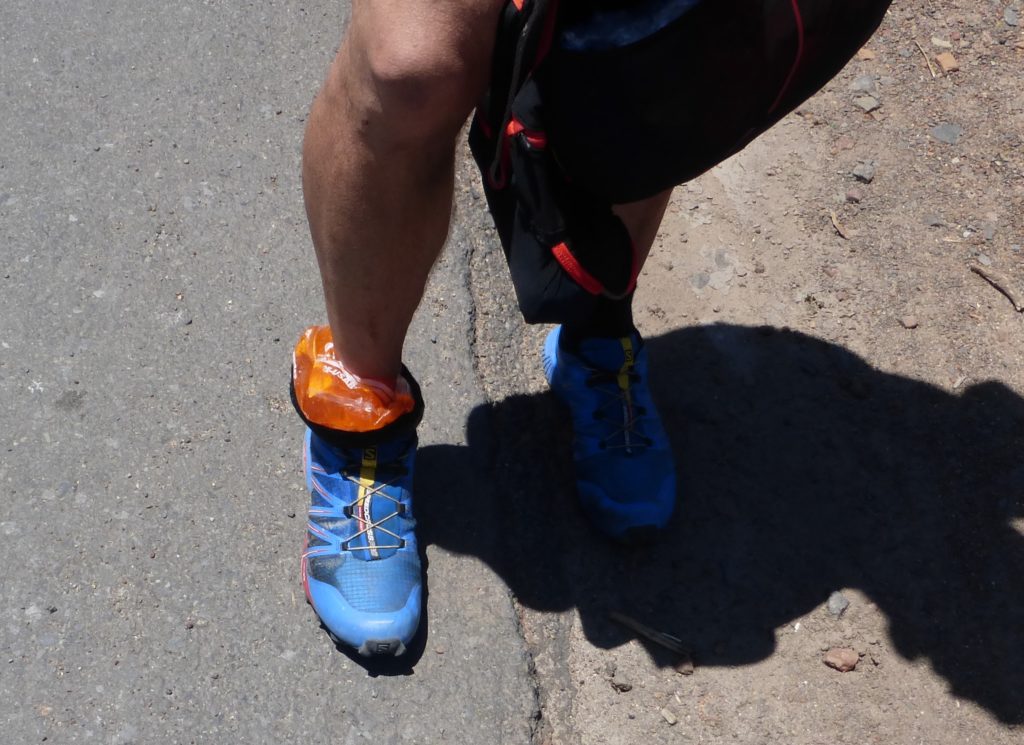
Andrew’s ice pack made me go further and it was good for the mood as well
I still could only run very slowly, even when we hit another road section for some 2 km, where I didn’t have to worry about an uneven surface. My pace was between 7 and 8 min/km on a very slight uphill road. Unusually slow for me. But that’s just the price I had to pay.
After the road section I met Henri again, but only for a few seconds, at a little stream. We had to cross the stream and he jumped from one boulder to the next. I stepped on the first one and tried to make up my mind. I had no confidence whatsoever in my right food. Jumping to the next boulder and landing on my right food would most likely not work. Starting on my right food would also not work, since I did not trust in the strength I needed to jump far enough. And I definitely didn’t want to slip, fall into the stream (which might have been a nice refreshment) and hurt myself hitting one of the boulders. So I walked further down the stream where I could walk through the ankle deep water. Usually I try to avoid soaking my shoes with water, but in this case… And I realised a few minutes later, that my Salomon Speedcross Pro shoes dry extremely quickly. Especially in more than 30°C ?
Aid Station #6 – Clay Cafe – 58 km
Finally I got to the intersection leading towards Aid Station 6, Clay Cafe. A Superwoman with red coat was standing there giving me directions. Very nice idea of this Aid Station crew, since the next marshals were also wearing superman/superwoman coats. I made my way, still walking, to the station to refill with water, eat some more water melon, drink a coke. I think I did not look good. One of the superwomen asked, if I’d like to clean my face and she did so using a wet wipe. That felt great.
It took me 1 hour and 10 minutes to cover the 8 km between the Aid Stations, on one of the easiest parts of the route!
I grabbed a banana and off I went. The next section was more uphill, in the beginning through a grass field and later along a jeep track. In the boiling heat. I ate almost the entire banana and this was the first time for more than 1.5 hours where I really wanted to eat anything (apart from water melon). After my third „roll“ my body was busy fighting the pain and increasing the inflammatory response, so it didn’t have any energy left for digestion. The iced ankle now might have numbed my brain and I got hungry. ?
In the meantime my crew had sent me a message that they’d be waiting for me not in Groot Constantia (at 67 km) but earlier at an informal Aid Station on top of Constantia Nek, some 3 km behind Aid Station 6 which I just left. That was my next goal.
My spirit was getting better as you can see in the video.It is unbelievable how hard it is to make the decision to stop or to carry one while you are in a race.
Of course what I said in the video was nonsense. Getting to UCT, the last Aid Station and ultimate cut off point, would require me to climb two more mountains and run through very difficult, technical terrain in the forests. No way would my ankle have been able to hold me. I thought about the challenges lying ahead of me already, but at the time of the video recording the ice might also have numbed my brain ?
It took me another 27 minutes to cover the 3 km between Aid Station 6 and Constantia Nek. A clear indication that I simply didn’t have the speed any more. And this was only due to the foot. My body itself felt great, no signs of massive exhaustion in my legs, no signs of cramps whatsoever.
On my way to Constantia Nek suddenly I saw Andrew waiting for me.
He ran next to me, wearing flip flops…
He also told me about a medic at Constantia Nek whom I might be able to consult.
When we eventually reached the Nek, Julia and Silke refilled my water flasks while I spoke to the medic. Well, what he told me was clear upfront: If I’d continue running, the recovery would take much, much longer and I might injure myself even more. He said, if he’d be running, he’d pull the plug now.
I said „Well, you wouldn’t have started in the first place“, and he agreed.
You see, he was absolutely right. From a medical perspective it was not responsible to continue. But that’s what runners do.
Andrew gave me a new ice pack, we fixed it to my leg and decided to meet at Groot Constania, short 5 km down the hills.
Making decisions during a race is VERY difficult
What was supposed to be a lovely run through some vineyards and the beautiful Constantia turned into the final phase of my decision process. I was simply not able to make up my mind on my own. So I called my wife. I told her, that she might not be able to help me, but that I simply needed to talk.
I explained to her what happened, tried to calculate the times and if I would still be able to make it. I still had 6 hours to go for some 34 km. Not too bad! In training I would do that easily. Eventually I spoke about my fears regarding the technical forest sections and that I was scared that I would roll my ankle again and eventually end up with torn ligaments in my foot. I was certain that so far the ankle was sprained but nothing torn. When I mentioned this, I got some tears in my eyes and knew, it was over. She was very supportive and told me, that whatever decision I would make, it would be the right one. While we spoke for maybe 15 minutes, I walked all the time. We closed our call with the agreement that I would speak with my support team at Groot Constantia, all runners themselves, to make the decision.
When I hung up the phone, I felt relieved. Actually I had made my decision, and then I shot this video, continuing walking instead of running:
Then I entered the grass field at Groot Constantia after 10h 56 min, 67 km into the race. The team at the Aid Station was very supportive and upbeat, trying to keep up my spirits. As I had not yet seen my friends, I spoke to the time keeper that I might come back later…
One runner sat behind the tent, and he told me that he withdrew since he felt sick for a long time already. And to my surprise I saw Henri again. His family was there, he enjoyed some proper food and we spoke about his decision to continue his run. I told him, that I’m about to quit, but he was determined. His foot had turned blue and still able to run. I shared the cut off times with him, so he knew what to pay attention to.
Then I gave my support team a call and it turned out that they were waiting for me just a few meters away. Andrew came running with his cooler box, followed by Julia and Silke. I opened the conversation and shared my thoughts of withdrawing. They immediately came to the same conclusion and we called it a day. Nothing happens without a reason, and the location couldn’t have been better – Groot Constantia has two restaurants and we decided to enjoy some beer and wine at Simon’s restaurant. But before we could do that, I still had to inform the officials at the Aid Station.
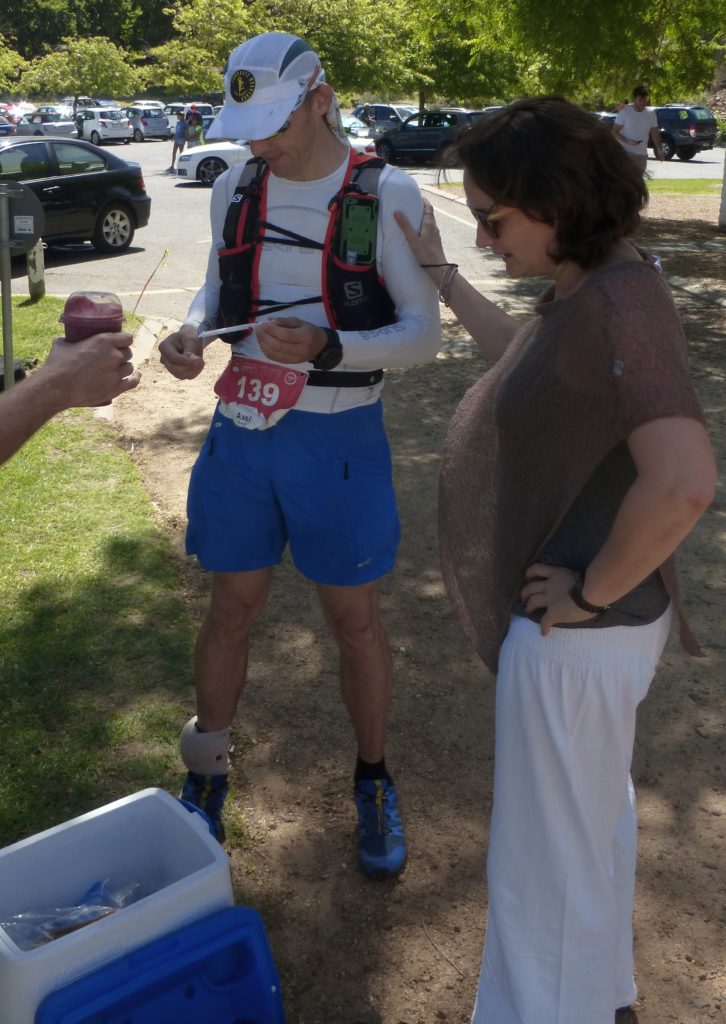
The decision is made, supported by friend Silke, Andrew and Julia. I was looking forward to my smoothie 🙂
Andrew and I went back the maybe 100m to the station and we discussed his experience at 2015 Comrades when he was stopped due to cut off after running 82 km. The officials accepted my decision and told me, that I looked so fit. When I showed them my ankle they understood ? And that was it. My very first DNF and I did not feel sad at all. I knew, it is the right decision.
Then it was time for some rest and the four of us enjoyed beer and wine at the restaurant. Silke had my food and drinks (another smoothie and coconut water) to restock, but that was not necessary any more – and therefore Andrew, Julia and Silke started eating my race food ? and they loved it…
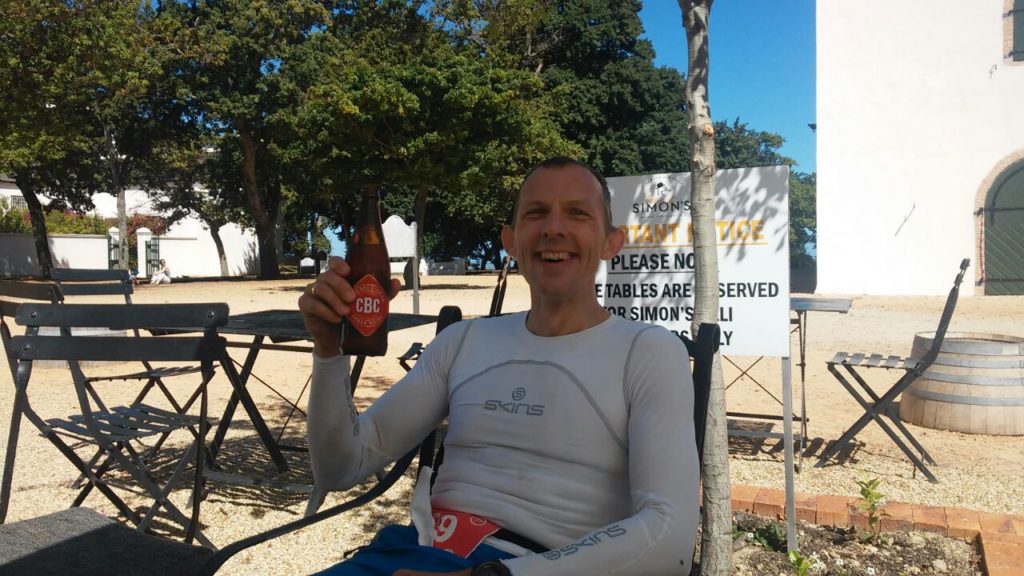
Ice cold beer… aaaahhhhh…
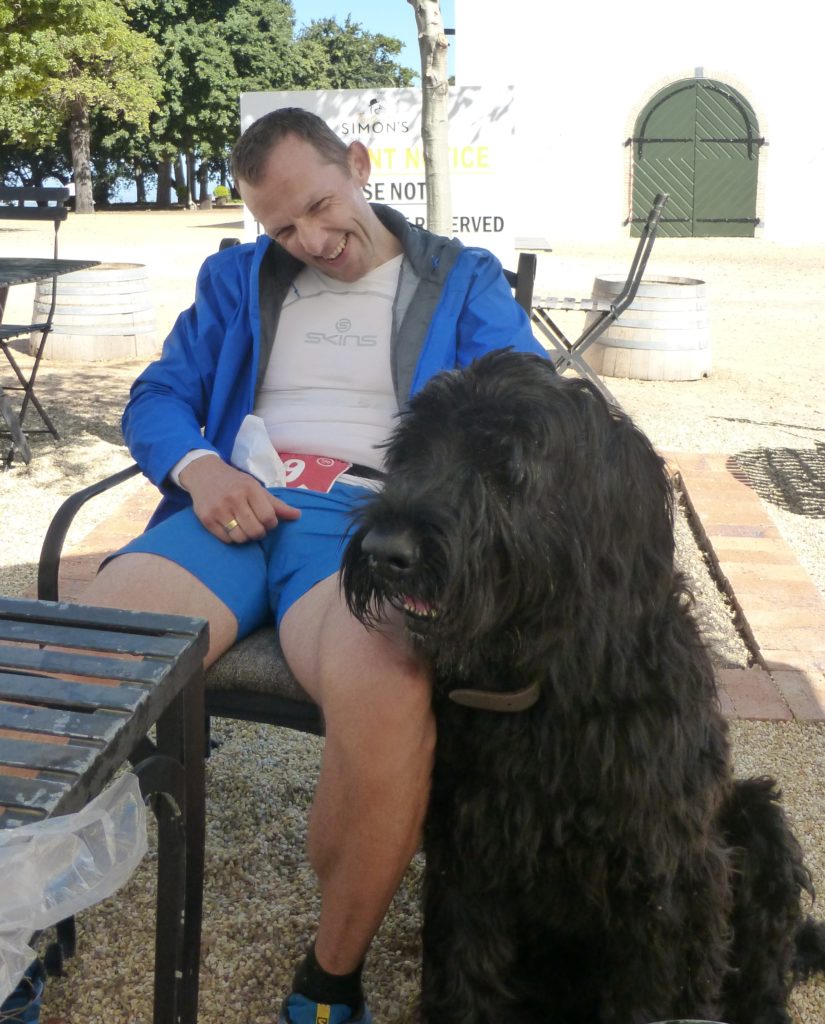
A fury new friend
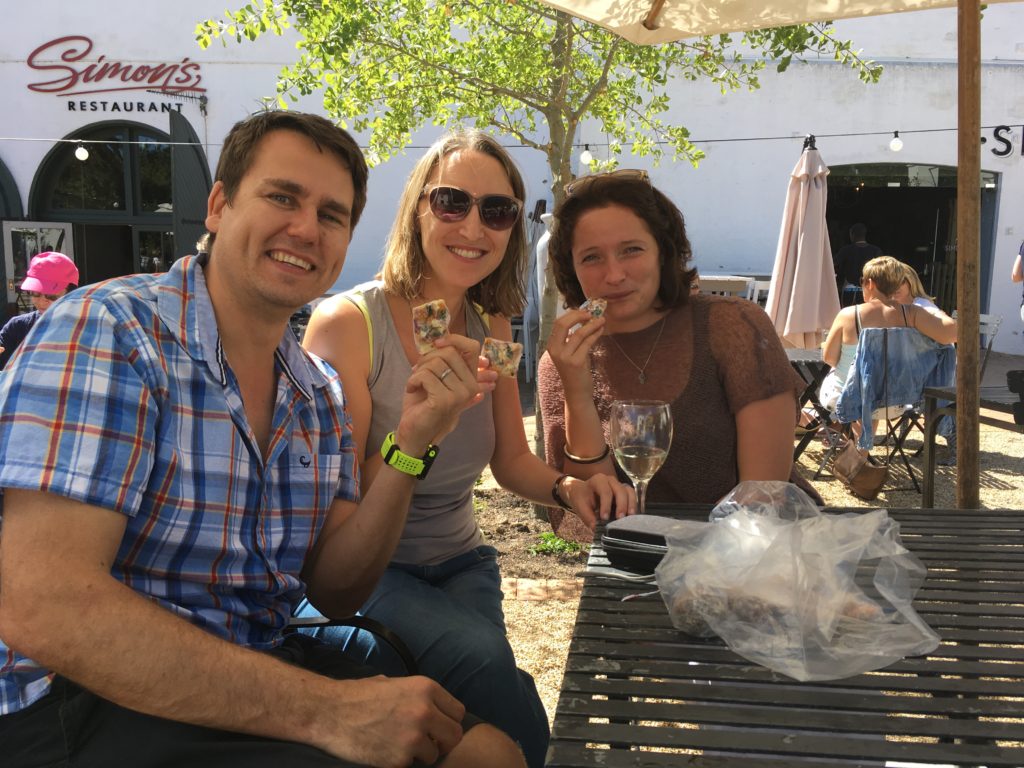
They kind of liked my supply of food for the race, which was now available to them 😉
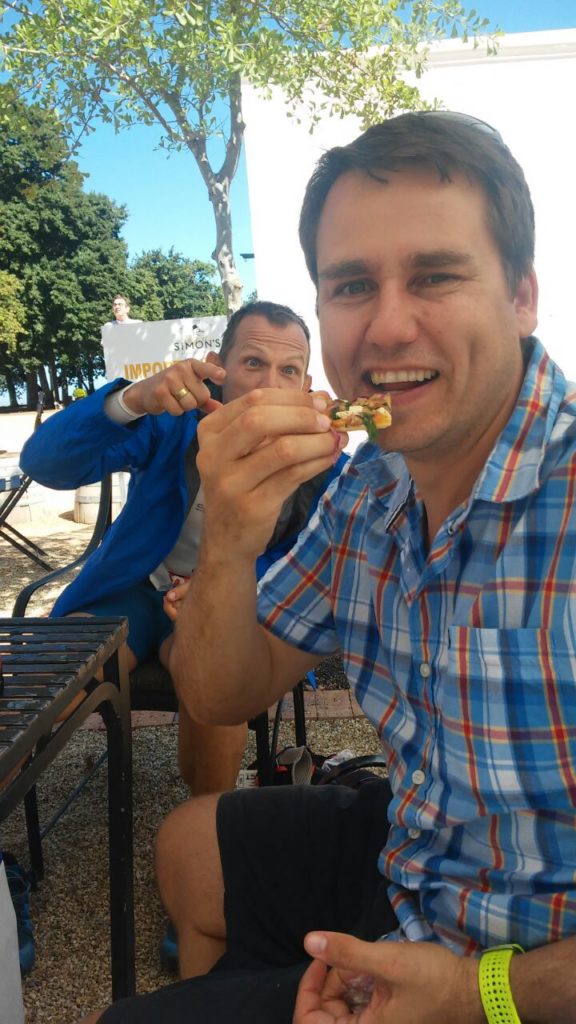
Andrew likes my runners food 🙂
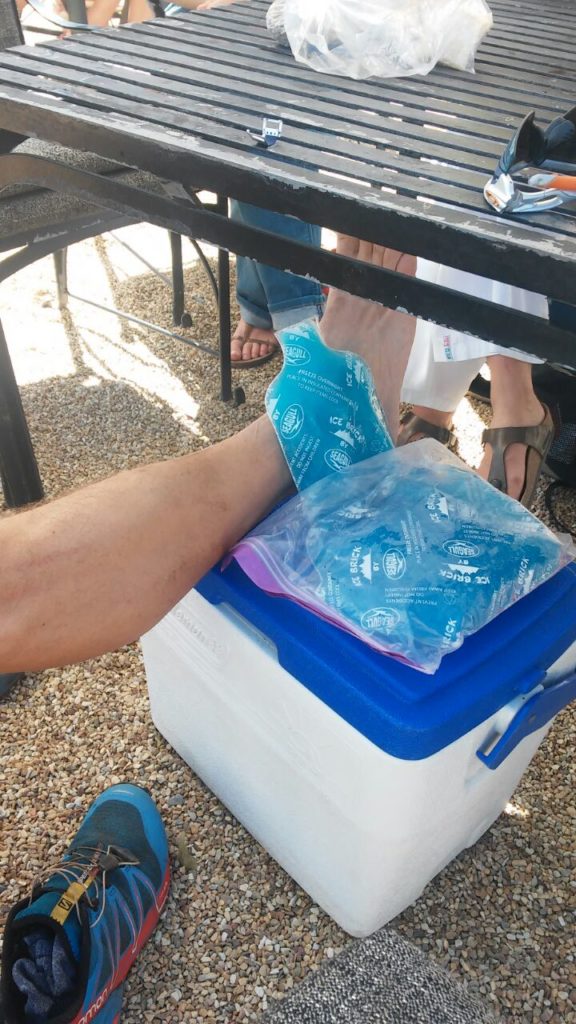
Icing the ankle right after the end of my race
When I got home I had the first proper look at my ankle and it was really swollen and not looking good. Luckily it did not get worse, even hours after stopping the race. That was a big relief for me and it confirmed my decision. The hours went by and I checked Henri’s progress, and it got really tight. He made the cut off at UTC by 6 minutes and finished in 17h 2 min. The organisers granted a 10 min grace period and he received his medal. I checked his progress on my phone, while I sat with my wife at dinner ? I thought that I could still be racing if I wouldn’t have rolled my ankle – but that was fine with me.
I knew I was prepared well enough for the race, I would have finished it, I did nothing wrong. Stumbling, falling, rolling an ankle are part of the risks you take when running trail. That’s what makes it extra special, hard, worthwhile.
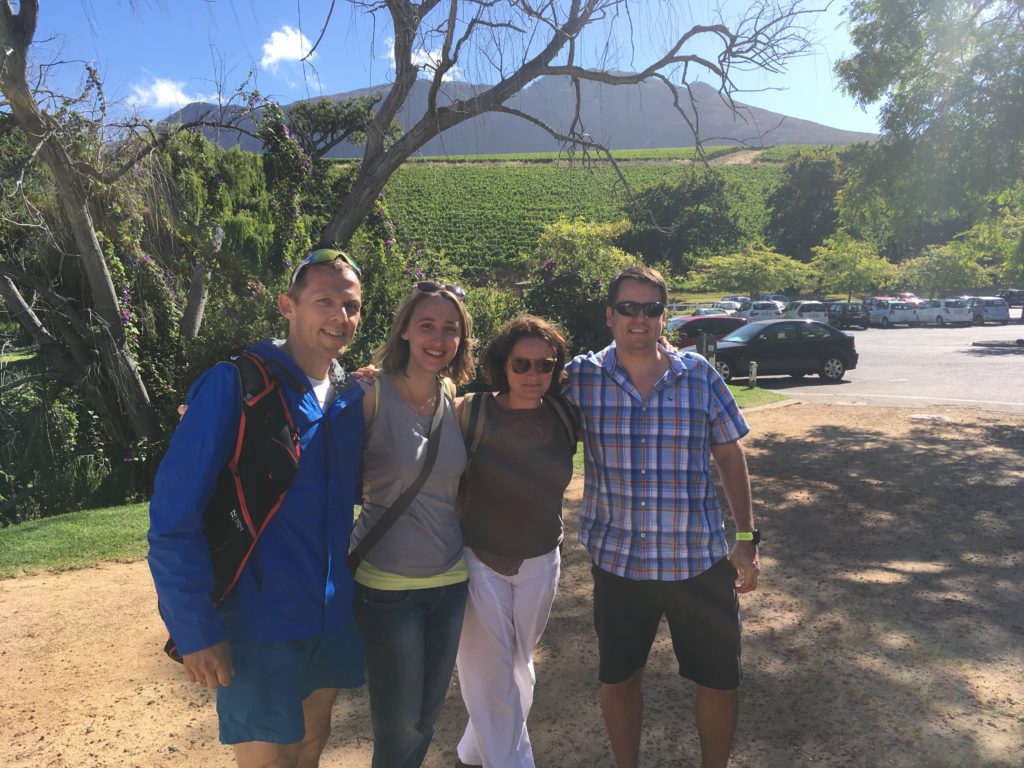
My awesome support team I am priviledged to call friends – Julia, Silke and Andrew. You are the best!
The aftermath
The very next morning I walked our dogs, and as you can see in the video, I was moving extremely slowly. The pain did not get worse, which I read as a good sign. I made an appointment with my physio for Tuesday (3 days after the race). In the meantime I rested, elevated and iced the ankle.
When I saw the physio on Tuesday he immediately congratulated me for my decision and told me, that I would most like have torn my ligaments if I’d have tried to finish the race. He assessed my ankle and it turned out to be a „grade 1“ injury. 3 weeks no running, immediately starting with some exercises to strengthen and re-train the ankle and my brain. That was the ultimate relief and confirmation for my decision to stop.
I learned a lot about how the ankle works and that a first roll is often the start to another one due to the way the ankle and the nerves work. I know now: If I roll my ankle 2x subsequently in the future during a run or race, I’ll stop running if it’s a trail run.
In the meantime I also got a message from Henri. He had broken his little toe around the 30 km mark, was in a cast/boot and will be out of running for 10 weeks. A high price for finishing, but if my stability wouldn’t have been affected that much, I would also have continued and might have suffered a similar consequence.
My thoughts about UTCT Ultra Trail Cape Town as an event
Even if I did not finish, I really love the UTCT Ultra-Trail Cape Town. If you ever consider running a really tough and challenging trail race and want to do it in the most beautiful environment, please sign up for UTCT – no matter if you go 35km, 65km or 100km, you are going to love it – and you are going to suffer, but in a good way ?
I met wonderful people and found new friends especially during the recce runs, for which I am very grateful.
The statistics of the race speak volumes, especially the 50% drop off/cut off rate at the 100km race (the 30 “downgraded” runners either got redirected at Constantia Nek after 29 km due to not making the cut off or they chose to run the shorter route):
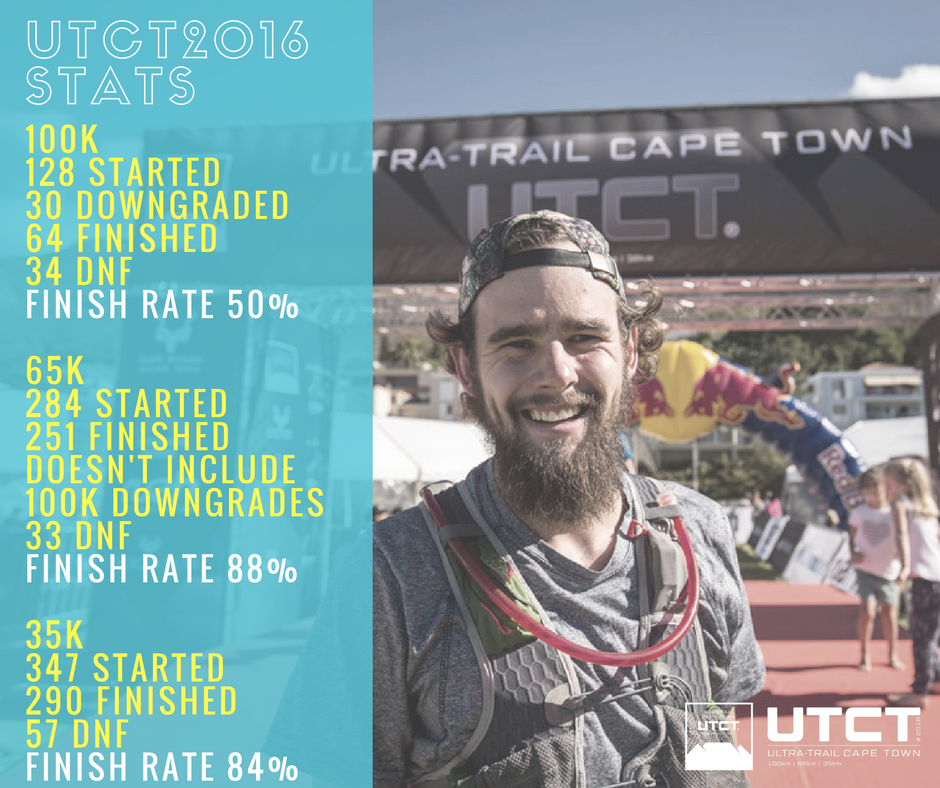
The UTCT 2016 finish statistics; picture (C) UTCT
Big thank you
A big thank you goes to my support crew Julia, Silke and Andrew for spending almost their entire Saturday. You are fantastic, thank you for being there!
And my wife Silke deserves a very special thank you. Training for such a trail race requires even more training than for a Comrades, in particular since the training runs are much longer (5-6 hours) than for a road ultra marathon. In addition to that she could not go running when I was out and about, since we received our new Vizsla puppy Lara at the beginning of October – and we could not leave such a young dog at home alone. Thank you my love!

